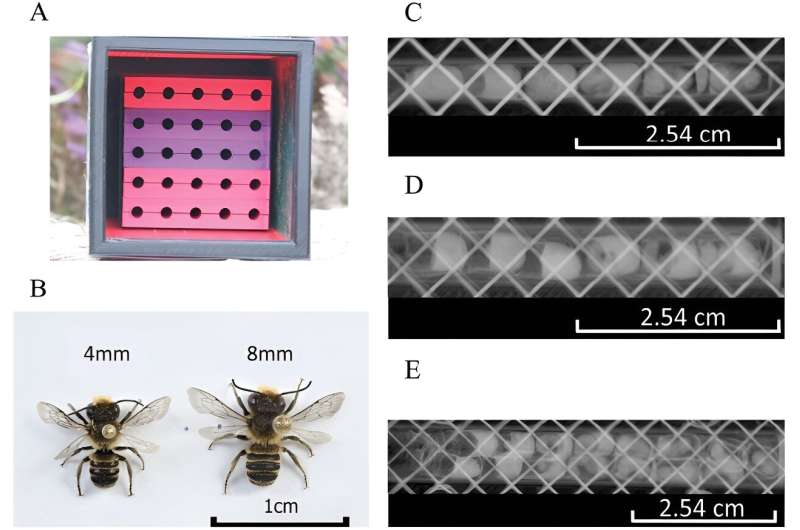This article has been reviewed according to Science X's editorial process and policies. Editors have highlighted the following attributes while ensuring the content's credibility:
fact-checked
peer-reviewed publication
trusted source
proofread
The right-size nest can maximize pollination capabilities of solitary bees

Solitary bees have a shorter lifespan compared to honeybees, usually lasting the spring or summer season. These bees have limited time to perform a lot of pollination work and they can use all the help they can get.
The USDA's Agricultural Research Service (USDA ARS), Insect Genetics and Biochemistry Research, participated in a study led by the North Dakota State University, that aimed to provide insights on how to help solitary bees maximize their pollination performance and to aid pollination management. The findings are published in the Journal of Economic Entomology.
The study focused on the alfalfa leafcutting bee (Megachile rotundata) to determine how modifying the nesting cavity diameter of solitary bees can enhance bee conservation, performance, and management practices. The pollination work by this species of solitary bee is crucial for alfalfa seed production.
There are more species of solitary bees than honeybees. Like honeybees, solitary bees are essential for pollinating crops and gardens, but unlike honeybees, they do not live in hives. Many solitary bees, like the alfalfa leafcutting bee, are cavity nesters and lay their eggs in natural cavities such as hollow twigs and holes in wood or digging underground tunnels.
Before laying their eggs, the mother bee determines the required amount of provisions, gathers the supply of nectar and pollen, and places it in the individual nest cells. Then, eggs are laid on the provisions for the larvae' development.
Gardeners and bee managers help increase the number of bees by placing "human-made" nesting holes around gardens to help the bees with nest construction. Another method is the use of "human-made" nesting boxes, which are also commonly used in commercial pollination managers to synchronize the time pollinators emerge with crop bloom.
An interesting fact is that the performance of solitary bees is not solely determined by their genetics but also by their body size. Furthermore, the size of the bee's body is influenced by the diameter of the nesting cavity and the amount of provisions left by the mother bee.
Bees that grow larger inside the cavities have been shown to have a greater foraging distance, making them better at spreading pollen. Therefore, the size of the nesting holes can either limit or maximize the pollination performance of the offspring. So, how can we determine the correct size and diameter for bee-nesting to maximize the production capabilities of solitary bee offspring?
Scientists examined the adult body mass and provision size of the alfalfa leafcutting bee. They collected samples from nesting boxes placed in the field. The boxes offered cavities ranging in diameter from 4 to 9 mm in 1 mm increments. After scientists examined all the measurements collected from the field nesting boxes, including the body sizes and provision measurements, they found that the size of the pollen provision was positively correlated to the bee's mass.
They also observed that bees' body size increased as the diameter of the nesting cavity increased, reaching a maximum size in the bigger nesting cavity diameters, with offspring emerging from 8 and 9 mm having the highest rate of winter survival.
In addition, the study found that various factors, such as gender, wing areas, wing loading, and overwintering, significantly influence the offspring when included in the analysis. The optimal nesting cavity size for the highest yield of offspring is 7 mm, while the best performance was observed in the 8 mm cavity.
On the other hand, the 5 mm cavity could be the best option for the conservation of other cavity-nesting bees. As the different nest diameters impact each of these variables differently, pollination managers should carefully choose a cavity size that aligns with their primary management objective.
"This study demonstrates the importance of different nest sizes for solitary bees," said Research Leader Joe P. Rinehart, with the Insect Genetics and Biochemistry Research in Fargo, North Dakota. "While larger nests result in larger bees that may be able to fly further, the medium nests produced more bees overall, and even bees from the smallest nests have the advantage of increased relative flight power, which means that they have the ability to carry relatively heavier loads than their larger counterparts."
What is next? Scientists will continue researching to find answers to additional questions, including more detailed studies on the costs and benefits of being a larger or smaller bee.
More information: Joshua D Rinehart et al, Nesting cavity diameter has implications for management of the alfalfa leafcutting bee (Hymenoptera: Megachilidae), Journal of Economic Entomology (2023). DOI: 10.1093/jee/toad207
Journal information: Journal of Economic Entomology
Provided by United States Department of Agriculture




















